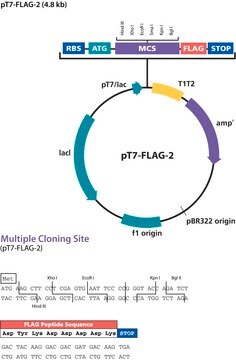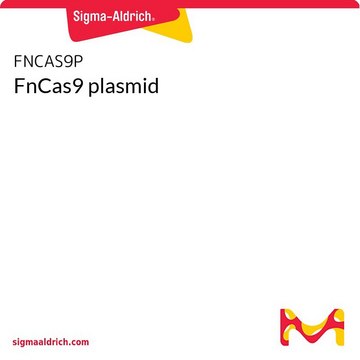OGS589
PBR322 - PBR322 LOW COPY CLONING VECTOR
plasmid vector for molecular cloning
Synonym(s):
cloning vector, expression vector, molecular cloning vector, plasmid, plasmid vector, snapfast vector, vector
Sign Into View Organizational & Contract Pricing
All Photos(2)
About This Item
UNSPSC Code:
12352200
NACRES:
NA.85
Recommended Products
form
buffered aqueous solution
mol wt
size 4361 bp
bacteria selection
ampicillin
Origin of replication
BR322 (15 copies)
Peptide cleavage
no cleavage
reporter gene
none
shipped in
ambient
storage temp.
−20°C
General description
This plasmid contains the BR322 (low copy number) origin of replication and provides approximately 20 plasmid copies per bacterial cell. It also contains the mammalian CMV promoter upstream of the MCS and Kan resistance for selection of transfected mammalian cells. Low copy number plasmids are useful for very large transgenes or for transgenes that can be toxic to bacterial cells.
Promoter Expression Level:
Promoter Expression Level:
Application
BR322 Information: BR322 is a wild type plasmid isolated from E.coli. It contains a low copy origin that allows for plasmid maintenance at a frequency of approximately 10-100 plasmid copies per cell. Typically this number is closer to 30-40 copies per cell. Most common cloning plasmids contain a derivative of the origin of replication in this plasmid called pUC. The pUC origin was created by removing the Rep repressor protein that normally regulates plasmid copy number in E.coli and also making a single point mutation in the origin of replication itself. The point mutation is the most important difference between the origin of replication.This plasmid can be used as a general purpose low copy cloning vector.
Sequence
To view sequence information for this product, please visit the product page
Analysis Note
To view the Certificate of Analysis for this product, please visit www.oxgene.com
related product
Product No.
Description
Pricing
Storage Class Code
12 - Non Combustible Liquids
Flash Point(F)
Not applicable
Flash Point(C)
Not applicable
Certificates of Analysis (COA)
Search for Certificates of Analysis (COA) by entering the products Lot/Batch Number. Lot and Batch Numbers can be found on a product’s label following the words ‘Lot’ or ‘Batch’.
Already Own This Product?
Find documentation for the products that you have recently purchased in the Document Library.
Geoffrey M Lynn et al.
Nature biotechnology, 33(11), 1201-1210 (2015-10-27)
The efficacy of vaccine adjuvants such as Toll-like receptor agonists (TLRa) can be improved through formulation and delivery approaches. Here, we attached small molecule TLR-7/8a to polymer scaffolds (polymer-TLR-7/8a) and evaluated how different physicochemical properties of the TLR-7/8a and polymer
Jin-Gyoung Jung et al.
PLoS genetics, 10(10), e1004751-e1004751 (2014-10-31)
The Notch3 signaling pathway is thought to play a critical role in cancer development, as evidenced by the Notch3 amplification and rearrangement observed in human cancers. However, the molecular mechanism by which Notch3 signaling contributes to tumorigenesis is largely unknown.
Diana Romero et al.
Carcinogenesis, 37(1), 18-29 (2015-10-28)
Dickkopf-3 (Dkk-3) is a secreted protein whose expression is downregulated in many types of cancer. Endogenous Dkk-3 is required for formation of acini in 3D cultures of prostate epithelial cells, where it inhibits transforming growth factor (TGF)-β/Smad signaling. Here, we
Alexander C Cerny et al.
PLoS genetics, 11(10), e1005578-e1005578 (2015-10-29)
Recycling of signaling proteins is a common phenomenon in diverse signaling pathways. In photoreceptors of Drosophila, light absorption by rhodopsin triggers a phospholipase Cβ-mediated opening of the ion channels transient receptor potential (TRP) and TRP-like (TRPL) and generates the visual
Our team of scientists has experience in all areas of research including Life Science, Material Science, Chemical Synthesis, Chromatography, Analytical and many others.
Contact Technical Service








